Last week we visited Manzanar War Relocation Center on the East side of the Sierra Nevada Mountains on the inland edge of California.
After the Japanese attacked the United States at Pearl Harbor in December 1941, Americans were suspicious of any persons of Japanese descent, particularly along the West Coast of the US. These vague suspicions led to immediate arrests, and two months later, President Roosevelt signed an Executive Order to exclude ‘any or all persons’ from proscribed military areas. In plain words what this meant was that anyone of Japanese ancestry had to be relocated from the entire West Coast of the United States. The order also mandated the creation of relocation centers to house those who were to be removed. In the beginning, those relocated were told it was for their own protection. One woman wondered why if it was for their own protection, the guards pointed bayonets into the camps, and not away from them.
As explained in the National Park Service Guide: “In 1942, the United States government ordered more than 110,000 men, women, and children to leave their homes and detained them in remote, military-style camps. Manzanar War Relocation Center was one of ten camps where the US government incarcerated Japanese immigrants ineligible for citizenship and Japanese-American citizens during World War II.” Manzanar was one of the smaller camps, holding over 10,000 inmates during the four years it was open, between March 1942 to November 1945.
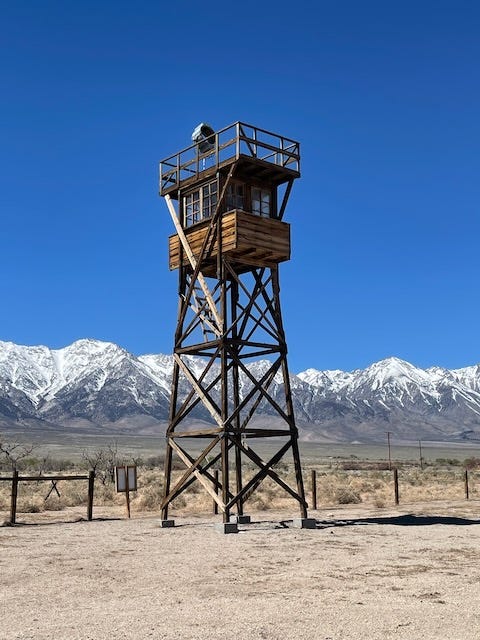
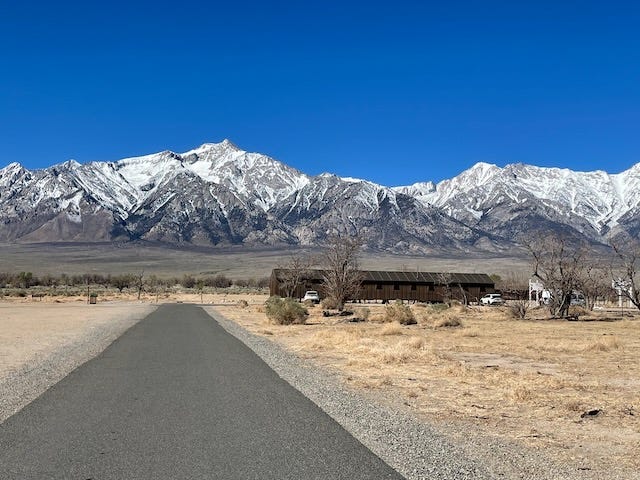
Two-thirds of the people who were ‘relocated’ to these camps were American Citizens. You read that right: American Citizens were forcibly relocated to the camps based only on their ancestry.
People of all different backgrounds, professions, incomes and geography were relocated from their beloved homes, gardens, and communities to this desolate camp far away from any towns or cities. Individuals and families from disparate places were assigned small wooden cabins with others they did not know, crammed together in a single big room. For four years they were imprisoned without having committed a crime.
There is much to see and learn—and mourn—in the camp structures that remain at Manzanar. The camp itself is in a desolate part of the world, which is known for fierce winds, intense winter cold and summer heat. It is so hard to imagine now what life was like for these thousands of displaced people trying to create some smidgeon of a normal life when everything familiar has been suddenly stripped away. They brought with them only what they could carry.
The next day we drove into Death Valley National Park. We finally timed one of our US visits with early spring—one of the best times to visit this park—since some of the hottest recorded temperatures in the world occur during the summer months. On this morning, we drove a rutted road to a more distant overlook where most tourists don’t bother to drive. As we reached the end of a slightly scary looking knob of land jutting out into what seemed like only air with no railing, we noticed a large group of motorcycles coming up behind us.
Oh great, I thought sarcastically, just when we wanted some peace and quiet, here comes a loud, probably obnoxious group of guys out for a jolly on their bikes. They all pulled in and parked near us. As we tried to ignore them, one of their group headed slowly over to us, extending his hand in a friendly way. “Hello” he said, “I’m Dan. We’re a group of friends cycling together for a few days; would you be able to take a photo of our group?” Well, of course we would be happy to do that.
He asked our names and then walked back over to his group. He called out to them, introduced us to the group explaining we were going to take their photo and they should circle round. We took their photos, then they offered to take our photo, only we insisted we be included with all of them. Afterwards we hung around chatting with several of the friendly group. They were very gentle, inquisitive and we really enjoyed talking to them. They take an annual biking trip together; I guessed they had served together in the military or had some similar experience that created such strong bonds.
Since our rental car had Kentucky plates they joked about whether we had brought any bourbon with us. But of course upon hearing Pete talk, they realised we were NOT from Kentucky and in fact they had met another British woman that morning who had been startled when five of them had stayed to assist one of their group who needed help with a repair. They were surprised that she didn’t understand that of course they would help one of their group. She was surprised that they would all stay and not just leave him on his own to catch up later. We were delighted to have met the guys and our lighthearted conversation with them. Each of us was surprised by the behaviour of someone else that day.
As I thought about that whole interaction I realised how easily I judge others, making assumptions about how someone might behave based on what they look like, or on an interaction from my past. Just as I had assumed the motorcycle guys were going to be loud, obnoxious and unruly, so too did previous Americans assume that after Pearl Harbour, all Japanese were likely spies and ‘bad guys". Even though I thought the kind of behaviour that resulted in Manzanar could never happen now, the very next day I had done exactly the same thing: I assumed a group of people who looked a certain way were going to bother me, without even being conscious of my unfair prejudice. Until I was proven so wrong.
On our last evening in Death Valley, we joined several hundred others watching the sunset and the rocks around us warm and glow. We heard languages from around the world, and accents from many regions around the US. People were taking silly selfies, and serious photographers steadied tripods and pointed their huge camera lenses. There were families and couples and groups of students and backpackers. And during this golden hour of the day, no one seemed in a rush or to care what anyone else was saying or doing. We were all there to sit quietly for a little while and let the colours of the world infuse us with their beauty. Knowing each colour has value in the light.
Thanks as always for reading this week!
I’ll be back in the UK next week so a wetter climate and of course garden updates! Take good care,
xx Sabrina
Clicking the little ❤️ button helps other people find this, and triggers a little happy dance! 💃
If you know anyone who might like to read these posts, feel free to send this one their way. Just click this button here:
And if you aren’t subscribing already, here’s the button for doing that (it’s free!):

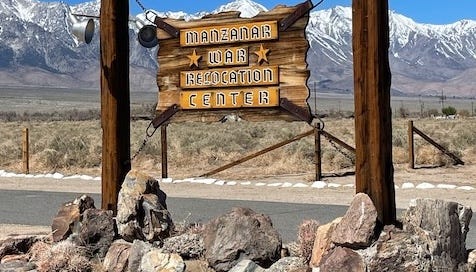





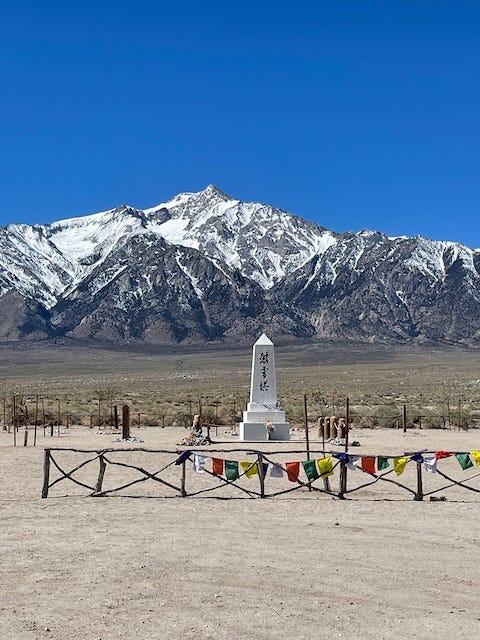
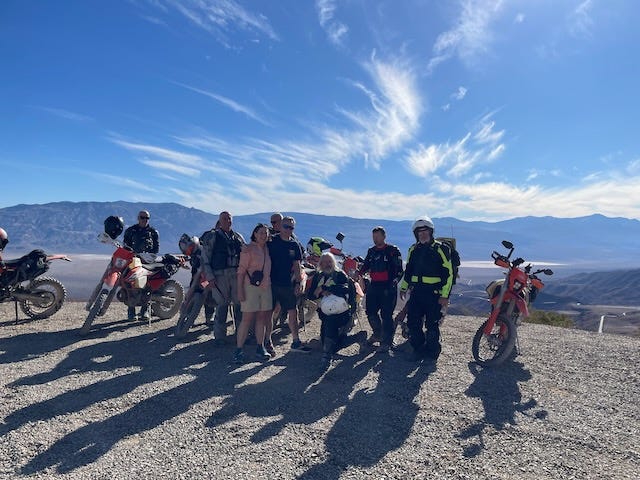

This is lovely, Sabrina - thanks! As you know, Sonya and I were similarly moved when we visited Manzanar en route to Death Valley in February 2023. It’s a sobering, even shocking, place, and one that I think every American should experience.
Thanks for sharing your trip to Manzanar. Was Tanforan Park in the East Bay mentioned.? It was a processing facility and I believe many Japanese-Americans were housed there as well. During TransAm bike race in 2019 I rode past the Amache Relocation Center near Grenada Colorado. I had no idea. Then I recollected there was another camp at Heart Mountain in Wyoming. Both were located in very remote areas. It is problematic to misjudge or stereotype and how guilty one feels when you find out "they" are very nice people. And when you find out they can be interesting people. Last year while we were in the Gulf Islands of BC, Canada we were talking with a Canadian couple. We have a number of Canadian friends and they asked how that came about. So we filled them in. But when we were alone I said to Kathy "because we're the nice Americans". Holy crap, look where we are now!